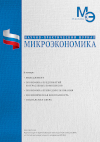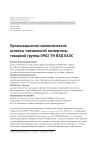Organizational and economic aspects of the customs examination of the commodity group 0902 of the customs code of the EAEU
DOI: 10.33917/mic-2.115.2024.62-74
The organizational and economic aspects of customs examination of commodity group 0902 of the EAEU TN FEA in modern conditions are considered. Features of the classification of tea and products made from it (commodity group 0902 of the EAEU HS) include the possibility of classifying a drink with the trade name «tea» to other groups of the HS. It is shown that the main data for correctly determining the HS code of a drink with the trade name «tea» are the degree of fermentation, composition and type, weight of packaging and purpose of the product. It has been established that in order to effectively identify tea and reduce the risk of erroneous classification under the Commodity Nomenclature of Foreign Economic Activity, it is necessary to improve existing identification technologies and regulatory documents for tea classification. It is substantiated that organizational and economic measures taken by the state to support the tea industry bring appropriate results, but complete import substitution of a drink with the trade name «tea» is practically impossible. Only partial import substitution is acceptable – this is the active development of the Russian industry for the production of fireweed (angustifolia fireweed).
References:
1. Bezpalov V.V., Filatov V.V., Zharikov R.V., Karev M.V. Features of customs regulation of imports of food and processing industry goods imported into the territory of the Russian Federation. Applied economic research. 2023;1:8–18. (In Russ.).
2. Alekseeva E.V. Ivan-narrow-leaved tea, a forgotten miracle of nature. Problems of the environment and natural resources. 2020;7:163–167. (In Russ.).
3. Babkina N.A. Commodity science, expertise in customs and commodity nomenclature of foreign economic activity. Amur State University, Blagoveshchensk. 2017. 230 p. (In Russ.).
4. Bikbulatova E., Plotnikova N.A. «Koporsky» fermented tea from the leaves of willow-leaved tea and Canadian maple. In the collection: Ecology and nature management: applied aspects. VI International Scientific and Practical Conference. 2016. pp. 63–65. (In Russ.).
5. Vaitekhovich A.A. The conjuncture of the tea market on a global scale. In the collection: Organizational and legal support of the management mechanism in the field of agribusiness. 2019. pp. 159–161. (In Russ.).
6. Vorontsov P.A., Dzik L.R., Zemlyakova E.S. Studies of black tea of different brands and assessment of its quality. Bulletin of Youth Science. 2021;5 (32). (In Russ.).
7. Gamidullaev S.N., Nikolaeva S.L., Zakharenko T.A., Simonova V.N. Commodity science and expertise in customs. St. Petersburg: Troitsky Bridge, 2010. 400 p. (In Russ.).
8. Dengina Yu.V., Tyulkina A.A., Darovskikh L.V. Research of some indicators of tea quality from different manufacturers. In the collection: Biodiagnostics of the state of natural and man-made systems. Materials of the XIV All-Russian scientific and Practical conference with international participation. 2016. pp. 375–378. (In Russ.).
9. Zakharov V.L. Ivan tea is a valuable domestic raw material for tea production. In the collection: Current trends in science and education. Collection of scientific papers based on the materials of the International Scientific and practical conference: in 5 parts. AR-Consult LLC. 2015. pp. 21–23. (In Russ.).
10. Ivleva D.Yu., Rastorguev R.E. The quality and safety of bayh tea of various names. In the collection: Priorities of world science: experiment and scientific discussion. Collection of materials of the II International Scientific and Practical Conference. 2019. pp. 106–109. (In Russ.).
11. Isanbulatova E.S. The export potential of Russia in the global tea market. Business strategies. 2022;10(3):57–59. (In Russ.).
12. Lakshita V., Andryashina N.S., Kuznetsova S.N. Comparative analysis of key competitive advantages of tea industry enterprises in Sri Lanka. Science, new technologies and innovations of Kyrgyzstan. 2022;2:102–105. (In Russ.).
13. Leshina E.A. Aspects of identification of some types of tea. Scientific notes of the St. Petersburg V.B. Bobkov branch of the Russian Customs Academy. 2007;2(28):45–63. (In Russ.).
14. Lyukshina D.A. Examination of the quality of a blend of green bayh tea using leaves of medicinal plants. In the collection: The contribution of young scientists to agricultural science. Proceedings of the International Scientific and Practical Conference dedicated to the 95th anniversary of the Samara State Agricultural Academy. 2014. pp. 300–305. (In Russ.).
15. Nikolaeva S.L. Investigation of the problems of examination and classification of tea according to the Customs Code of the EAEU under customs control. Scientific Notes of the St. Petersburg V. B. Bobkov Branch of the Russian Customs Academy. 2019;1(69). (In Russ.).
16. Romanyuk E.P., Nilova L.P. An integrated approach to assessing the consumer properties of black bayh tea. In the collection: SPbPU Science Week. Materials of the scientific conference with international participation. 2017. pp. 382–385. (In Russ.).
17. Slyadnikov D. Russian tea – ivan-tea – Kopor tea. In the collection: The polyline. Materials of the XI city conference. Edited by S.A. Yablokov, V.A. Nosov, S.A. Pishchulin. Saint Petersburg, 2022. pp. 136–141. (In Russ.).
18. Shavaleeva A.A., Nedorezova O.Y. Factors preserving the quality of food products, on the example of green bayh tea. In the collection: XIII Kama readings. Collection of reports of the All-Russian scientific and practical conference of students, undergraduates, postgraduates and young scientists. Naberezhnye Chelny, 2021. pp. 1127–1131. (In Russ.).



